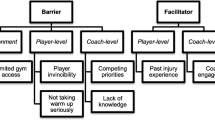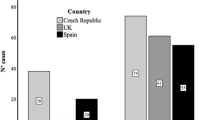Abstract
Objectives
Body checking is a significant risk factor for injury, including concussion, in youth ice hockey. Recent evidence regarding injury rates in youth leagues prompted USA Hockey to institute a national policy change in 2011 that increased the age of body checking introduction from 11–12 years old (Pee Wee) to 1 3–14 years old (Bantam). Body checking policy was more controversial in Canada, and research evidence alone was insufficient to drive change. The purpose of this paper is to provide an example of one of the knowledge exchange processes that occurred between researchers and community stakeholders, leading up to a national policy change in 201 3.
Participants
There were 28 stakeholder attendees, representing the research community, youth hockey organizations, and child health advocacy groups.
Setting
A one-day meeting held in Whistler, British Columbia, in April 2013.
Intervention
Researchers and stakeholders presented current perspectives on evidence and policy change, and discussion focused on an a priori set of questions designed to elicit facilitators and barriers to policy change.
Outcomes
Three major factors that can drive policy change in the sport safety context were identified: the need for decision-making leadership, the importance of knowledge translation, and the role of sport culture as a barrier to change.
Conclusion
There is a critical need for researcher and stakeholder partnership in facilitating ongoing policy discussion and informing evidence-based policy change in sport and recreation injury prevention.
Résumé
Objectifs
Les mises en échec sont un important facteur de risque de traumatismes, y compris de commotions, chez les jeunes joueurs de hockey sur glace. Des données récentes sur les taux de traumatismes dans les ligues pour les jeunes ont poussé USA Hockey à instituer en 2011 un changement de politique national qui a relevé l’âge d’introduction des mises en échec de la catégorie des 11–12 ans (peewee) à celle des 13–14 ans (bantam). La politique sur les mises en échec prête davantage à la controverse au Canada, où les données de recherche n’ont pas suffi à elles seules à faire changer les choses. Dans cet article, nous présentons l’exemple d’un processus d’échange de connaissances entre des chercheurs et des acteurs communautaires qui a mené à un changement de politique national en 2013.
Participants
Les 28 participants représentaient le monde de la recherche, les organismes de hockey pour les jeunes et les groupes de défense de la santé des enfants.
Lieu
La réunion d’une journée s’est tenue à Whistler (Colombie-Britannique) en avril 2013.
Intervention
Des chercheurs et des acteurs du milieu ont présenté les perspectives actuelles sur les données probantes et les changements de politique; la discussion a porté sur un ensemble de questions préparatoires conçues pour déceler les éléments qui facilitent ou qui entravent les changements de politique.
Effets
On a cerné trois grands facteurs pouvant amener des changements dans les politiques de sécurité dans les sports: le besoin de leadership dans la prise de décisions, l’importance de l’application des connaissances et le rôle de la culture sportive en tant qu’obstacle au changement.
Conclusion
Il y a un besoin pressant d’un partenariat entre les chercheurs et les acteurs du milieu pour faciliter un débat de fond et éclairer les changements de politique fondés sur les preuves afin de prévenir les traumatismes dans les sports et les loisirs.
Similar content being viewed by others
References
Emery CA, Kang J, Shrier I, Goulet C, Hagel B, Benson B, et al. Risk of injury associated with body checking among youth ice hockey players. JAMA 2010;303(22):2265–72.
Emery CA, Kang J, Shrier I, Goulet C, Hagel B, Benson B, et al. Risk of injury associated with body checking experience among youth hockey players. CMAJ 2011;183(11):1249–56.
Emery CA, Hagel B, Decloe M, McKay C. Risk factors for injury and severe injury in youth ice hockey: A systematic review of the literature. In J Prev 2010;16:113–18.
Statistics Canada. Teaching checking: A progressive approach. Available at: https://doi.org/www.hockeycanada.ca/en-ca/Hockey-Programs/Coaching/Checking (Accessed October 11, 2013).
USA Hockey Coaching Education Program. Checking the right way for youth hockey: A coaching clinic curriculum for five instructional lessons. Available at: https://doi.org/www.usahockey.com/page/show/908033-body-checking-rule (Accessed October 11, 2013).
USA Hockey Player Development Committee. Subcommittee on body checking recommendation. Available at: https://doi.org/www.usahockey.com/page/show/908033-body-checking-rule (Accessed February 26, 2014).
Max Bell Foundation. Available at: https://doi.org/www.maxbell.org/what-we-do (Accessed October 11, 2013).
Houghton KM, Emery CA. Body checking in youth ice hockey. Paediatr Child Health 2012;17(9):509.
Author information
Authors and Affiliations
Corresponding author
Additional information
Acknowledgements: We thank all meeting participants for their collaborative efforts in ensuring that this knowledge exchange was successful, and for their contributions to the revision and approval of this manuscript (Ralph Strother, Paul Melia, Paul Carson, Kevin McLaughlin, Vanna Achtem, Yves Archambault, Shelina Babul, Bill Barrable, Kathy Belton, Anne Deitch, Phil Groff, Dean Hengel, Larry Jeeves, Alison Macpherson, Sue Makarchuk, John Philpott, Laura Purcell, Aynsley Smith, Andrea Winarski). Thank you to Gabriella Nasuti and Maria Romiti for providing administrative and technical support for the meeting.
Funding: The policy discussion meeting was supported by the Max Bell Foundation.
Conflict of Interest: None to declare.
Rights and permissions
About this article
Cite this article
McKay, C.D., Meeuwisse, W.H. & Emery, C.A. Informing body checking policy in youth ice hockey in Canada: A discussion meeting with researchers and community stakeholders. Can J Public Health 105, e445–e449 (2014). https://doi.org/10.17269/cjph.105.4653
Received:
Accepted:
Published:
Issue Date:
DOI: https://doi.org/10.17269/cjph.105.4653




